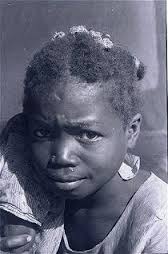
The BBC recently had a photojournal article on the lost Africans of India, and I thought it wise to talk about our brothers from the Indian subcontinent. The Sidi or Siddi, or Sheedi, or Habshi, are said to have first arrived on the Indian subcontinent around 628 AD at the Baruch port. Several others followed; most Siddis are believed to be descendants of traders, sailors, soldiers, servants, and merchants of East Africa. The biggest wave of migration is said to have lasted between the 12th and 19th centuries. Most Siddis are Bantu descendants from southeast Africa. In the 13th and 14th centuries, most slaves were mainly drawn from countries in the Nile region: lower Egypt, Ethiopia, Somalia, and Sudan. Due to their fighting prowess, many became soldiers in the armies of conquerors and sultans all over India’s princely states. They were wanted mostly because of their loyalty and strength, and received grants of land in return for their valorous services. With the arrival of the Europeans, especially the Portuguese, into the slavery scene in the 16th century, Siddis were now drawn from the inner continent in regions such as the Congo, and as far down the East African coast as Mozambique, Malawi, and Tanzania.
The origin of the word Siddi is very controversial. Some believe that it was a term of respect in North Africa similar to the word sahib used in India; others believe that it derived from the title borne by the captains (known as sayyib) of the Arab vessels that first brought Siddi settlers to India; while others believe that the word habshi (another term for siddi) is derived from the common name for the captains of the Ethiopian/Abyssinian ships that also first delivered Siddi slaves to the subcontinent.

Today, many Siddis reside in the Western states of Karnataka, Gujarat and Maharashtra, with some in the city of Hyderabad in India and Makran and Karachi in Pakistan. India counts about 20,000 to 50,000 Siddis. Their communities are very poor, and many have kept together, and do not marry outside. Siddis are mostly muslims, but some are christians; with few adopting Hindu as they could not fit appropriately in the Hindu caste society. Today, the Siddis are called a ‘scheduled caste‘, or ‘scheduled tribe‘, which simply gives them access to reserved quotas of government jobs, quotas in state schools, bursaries and subsidized housing. As is the case with the descendants of black slaves in the Americas, most of the Siddis of India do not know where their ancestors came from in Africa, but, amazingly, they have somehow preserved some of the musical and dance traditions of their long-lost forefathers (again, similar to Africans in the Western Hemisphere). Their African-derived music is known as the Goma and is clearly African in origin.

Many of the well-known Siddis in Indian history were war generals. One of them was Jamal-ud-Din Yaqut who rose to prominence in the Delhi Sultanate period prior to the rise of the Mughals of India, as a close confidant of Razia Sultana (1205–1240 CE); it has been speculated that he was her lover. Many of the kingdom’s noblemen resented the relationship between Razia Sultana and Yaqut, first since she was the first female ruler of the Delhi sultanate, but also because she elevated him to the great title rank of Amir of Amirs. Other important Siddis have been Yakut Khan, a naval admiral and administrator of Janjira fort who served under the reign of the Mughal Emperor Aurangzeb; and Malik Ambar who created an army of over 1500 men on his own; and general Hoshu Sheedi, who was a Supreme Commander of Sindh‘s Talpur army, who fought with valor against the British in the Battle of Dabbo and laid down his life in defense of his country.
Lastly, it is good to note that Africans have influenced civilizations around the world, and continue to influence them to this day: many great cities and empires were built thanks to them. Imagine that some of the great generals and confidants of the Mughal empire were of African descent… doesn’t that make you proud? To learn more about the Siddis of India, don’t forget to check out BBC’s photojournal. Please read the article on The Lost Indians on NigerianMasterweb.com, India’s Sidis on The East African journal, as well as the article in the International Business Times.


I’m so grateful for your post.Truly thank you! Will read on…
LikeLike
I really liked reading your post. It’s very insightful and distinctive. Your points are well presented and simple to understand. Thanks for the high quality content.
LikeLike
Pingback: African Presence in India | African Heritage
Pingback: 10 Remarkable Communities Founded By Former Slaves | ratermob
Pingback: 10 Remarkable Communities Founded By Former Slaves – Nails Polish
This is very nice yah
LikeLike